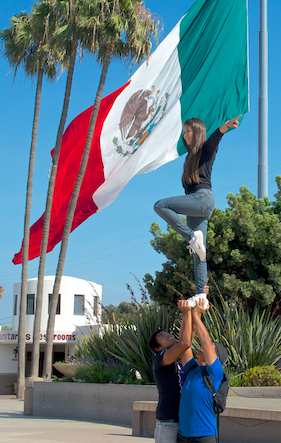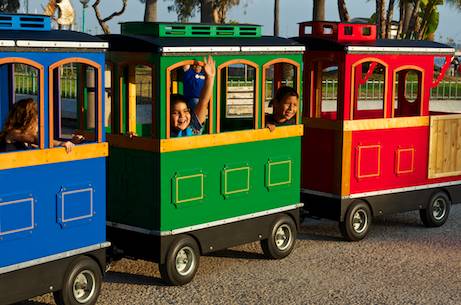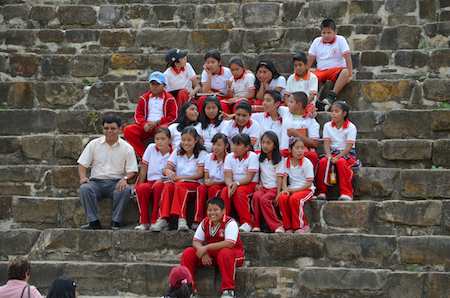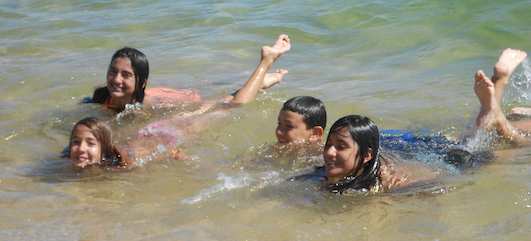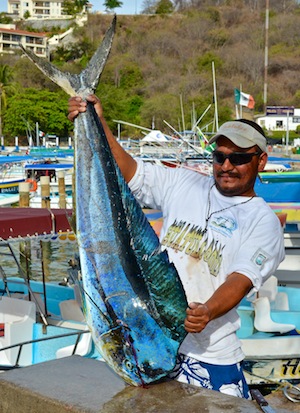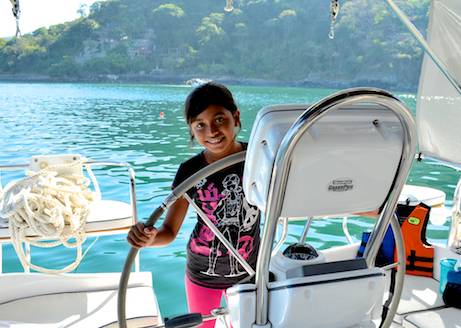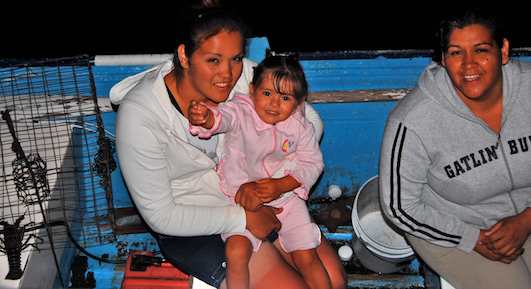When folks find out we’ve been living and traveling in Mexico for a few years, we are frequently asked: Is Mexico safe??
Mexico has been in the headlines a lot recently as the country has engaged in its infamous drug wars. Tragically, tens of thousands of people have died. So we’re not surprised to hear this question so often.
However, we have felt as safe or even safer in Mexico than we have at home in the US.
More important, we have discovered our southern neighbor is full of friendly people, really fun towns and has a fascinating history, from both ancient times when step pyramids were in vogue and more recent times since the Spanish arrived.
It is always easy to be frightened of a place we’ve never seen in person. Reading the news coming out of our own hometowns lately — Boston for me and Detroit for Mark — we might think twice before going to either city if we hadn’t already been there, done that, and lived to tell the tale. Both cities have made headlines in the last six months, one for gruesome attacks on innocent people and the other for taking a trip down the road of corruption to bankruptcy.
Wait a minute! Isn’t Mexico the place that is known for gory crime and corruption, and not the US?
Bobbing around at anchor in a sailboat on the Mexican coast while reading these disturbing headlines about these frightening American cities, we have the same reaction as folks do up north when they are kicked back in their cozy living rooms in friendly American and Canadian communities, reading about the freaky goings-on south of the border.
For all of us, our first reaction is naturally, “Thank God I’m not there!” The second really should be, “Is that the only thing that’s happening there? Is there really no one living a normal life in that place?”
Whenever we open up Google News to see what’s going on in the world, we are always horrified by the daily muggings, robberies, murders and general mayhem that is happening in our adopted hometown, Scottsdale, Arizona. Scottsdale is a chic vacation destination for lots of snowbirds, and it’s a city that considers itself quite swank and rather trendy. But good grief, they have stabbings in the bars and murders in the streets there! Stay away!!
The media loves to shock us and they do a really good job.
It is hard to measure the “safety” of a community in precise terms. Crime is a very black and white matter — either you are the victim of a crime or you slide by unscathed. You aren’t “kinda” mugged or “sorta” killed. So, looking at crime statistics is rather bizarre. If the murder rate for a city is 40 per 100,000, or perhaps 380 per year, what does that really mean to the average tourist that arrives on that city’s streets? Will you be attacked while toting your suitcase to your first hotel or will it happen after a month or a year or a decade?
Contrary to the terrifying news stories splashed across the US media, the US government’s current travel advisory for Mexico opens with the following very benign assessment of the situation for Americans traveling to Mexico:
“Millions of U.S. citizens safely visit Mexico each year for study, tourism, and business, including more than 150,000 who cross the border every day. More than 20 million U.S. citizens visited Mexico in 2012. The Mexican government makes a considerable effort to protect U.S. citizens and other visitors to major tourist destinations, and there is no evidence that Transnational Criminal Organizations (TCOs) have targeted U.S. visitors and residents based on their nationality. Resort areas and tourist destinations in Mexico generally do not see the levels of drug-related violence and crime that is reported in the border region and in areas along major trafficking routes.”
So, in a nutshell, almost 7% of the US population visited Mexico last year. If that’s true, it can’t be all that dangerous, can it?
A statistic that is not mentioned in this report but that I have read elsewhere is that a million Americans and Canadians make their homes in Mexico. Many have long term residence visas, and quite a few have had access to the free public health care system, us included. Now that’s a twist, isn’t it?
I think that when reading headlines and stories about the dangers in Mexico, it is worthwhile to take a look in the mirror and think about the dangers of living at home, wherever home is.
The NY Times published an article recently stating that in 2012 Detroit had 386 murders (more than one a day) and Indianapolis had 101 (one every 3-4 days).
Meanwhile, ABC News published a story about the worst neighborhoods in the US, and found that in certain parts of Atlanta, Georgia, your chance of being the victim of a violent crime is 1 in 12, while in Nashville, Tennessee, it is 1 in 14 and in Tulsa, Oklahoma it is 1 in 15.
I’m not sure how to interpret those statistics. It sounds like out of twelve people walking down certain streets in Atlanta, one will fall prey to a violent crime!! Holy cow!! Run away!! However, thousands of people live and work in Atlanta, Nashville and Tulsa very happily every day. Statistics tell only part of the story.
Perhaps more important is that crime everywhere is localized and focused in specific areas. We all tend to brush off the stories of violence that happen around us in our home towns, because they happen “over there” somewhere, whether “over there” is a few miles away downtown or a few streets away where the neighborhood starts to get iffy. The thing is, at home, we know where the dangerous places are, and we don’t go there, or at least we don’t go there late at night and alone.
The same is true traveling in Mexico, or anywhere for that matter. Mark and I have stuck to the tourist trail — after all, those are the places that we want to see, just like everyone else — and we have done our wanderings in the daytime and early evening. The precautions we would take if we were to venture to the more dangerous parts of Phoenix, Arizona, are the same precautions we have taken in Mexico. Of course!
Whereas in San Diego we locked our dinghy and outboard to the public dinghy dock with a thick chain and padlock because we had heard stories from other boaters of rampant dinghy and outboard thefts there, when we were in Zihuatanejo and Huatulco Mexico, we happily left the dinghy unattended and unlocked all day every day for weeks on end. We never had a problem.
Of course crime does exist in Mexico, as it does everywhere, but it is localized, just as it is elsewhere. And the most violent and grisly stuff we all see in the news is not targeted against tourists and takes place far from the tourist destinations.
Friends of ours had their outboard stolen while anchored in Mantechen Bay, an area in Mexico well known among boaters for outboard thievery. We were also particularly cautious in parts of Acapulco and Mazatlan, cities known to be more dangerous than other places in the country.
To me, however, it is much more frightening to think of a life lived without leaving home and seeing some of the world than it is to face the fear of traveling, even to a place that has made headlines for violence.
If fear keeps you from venturing out, and you let the terrifying headlines fence you in, you will miss out on some of the most beautiful experiences life has to offer.
The Mexicans we have met have taught us the true meaning of graciousness and kindness to strangers. It is a lesson we hope to take home with us.
From the guy on the street who turned around 180 degrees and walked with us for four blocks to make sure we got where we wanted to go, to the guy that drove us 30 miles, in his own truck, to a mechanic who could rebuild our alternator and who stayed with us all day until we had the fully repaired alternator in hand, we have learned the precious value of watching out for your fellow man, not for personal gain, but just to be nice — because we’re all living this life together.
The kindness, generosity and warmth we have found in Mexico is exceptional, and it is virtually universal. Our lives have been immeasurably enriched by our travels here.
If you have the opportunity to visit Mexico but have held back because you think it might be dangerous, all I can say is: GO FOR IT!! You’ll be so glad you did.
Travel Tips – Visiting Mexico by Sailboat and RV
Our travels in Mexico so far have been by sailboat along the Pacific coast and Sea of Cortez, and by long distance bus inland from the coast. We have several posts on this site with tips for traveling this way:
- Mexico Cruising Guide – Weather, Navigation, Tides, Sailing,
Boat Prep, Culture, Language and more - Insider’s Guide to Cruising Mexico – Check-in, Provisioning, Banking, Boat Parts, Internet Access, Laundry, Costs and more
- Mexico By Bus – Tips for long distance bus travel in Mexico
We have not traveled in Mexico by RV, but lots of people do. Two useful resources for planning an RV adventure in Mexico are:
- Mexican Camping – by Mike and Terri Church, long-time veterans of RVing in Mexico
- On the Road In – Comprehensive info about Mexico, including RV Park reviews & seminars.
For another perspective on safety in Mexico, check out this outstanding essay from the keyboards of the Lonely Planet Team:
Are Americans safer in Mexico than at home? I hope you take a trip to Mexico, and I hope you have as much fun and learn as much as we have!!



